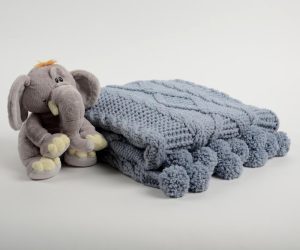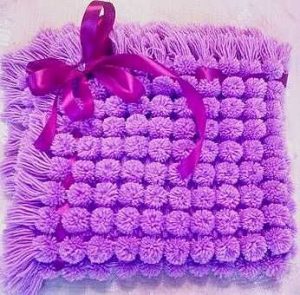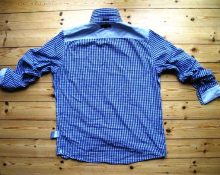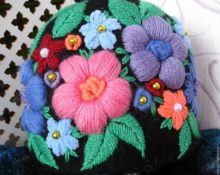
crafta.ua
In principle, it is not difficult to make a soft and cozy pompom blanket with your own hands. The most labor-intensive process is making the frame. Here you will probably have to resort to the help of a man. The rest of the work will be successfully handled by the needlewoman herself. Pompoms make an excellent children's blanket or blanket. The product is very soft, warm, can be plain or decorated with a variety of patterns and designs. You can make a whole knitted set with pompoms, for example, sew a pompom blanket, a pillowcase and an envelope for the baby. Before you sew a pompom blanket, you need to choose the right materials and make a base for the work.
Original do-it-yourself pom-pom blankets - a master class on choosing materials
Typically, craftswomen use cotton, acrylic or wool threads for creativity. Let's look at the advantages and disadvantages of each option:
- Wool yarn. Experts say that it has healing properties, perfectly warms the body, is able to remove moisture and prevent it from getting under the blanket.On the other hand, many people are allergic to woolen items. This blanket with pom-poms requires special care; it stretches or shrinks after washing. Over time and frequent use, the wool becomes covered with pellets. To evaluate the quality of the yarn, you should stretch it. The fiber will become smaller, but the threads must withstand the load and not break.
- Cotton threads. This is an environmentally friendly material that does not cause allergic reactions. Air flows circulate freely through cotton products. They can be machine washed by setting them to hand wash. The blanket will not lose its shape and will retain its color and size. However, the blanket will be quite heavy, so it is unlikely to suit a baby.
- Acrylic. The thread resembles wool in many ways. At the same time, it is resistant to sunlight, does not lose color, and does not wear out. The downside is that moisture does not pass through acrylic, but this compensates for the excellent level of thermal insulation. Machine washable, but only on delicate cycle.
Experts recommend giving preference to combined yarn, which contains a higher percentage of natural raw materials, but also contains an admixture of artificial material. To sew a pompom blanket you will need at least eleven hundred-meter spools of thread. Calculation for size 130x130.
Pompom blanket - master class on making a frame
Wicker frames are often called lums. To make them you need some plywood or wood strips, a set of slate nails and a hammer. Work process:
- Let's fasten 4 planks. The length of two of them is 145 centimeters. We place them in the lower and upper parts of the frame. The other two strips will be the sides of the frame. Their length is 137 centimeters.
- Slate nails are used for fastening. They can be replaced with large self-tapping screws.
- The frame will have a square shape.After installing the fasteners, the lengths of the sides will be equal.
- We use a hammer to hammer nails.
- We retreat from the corners about eight centimeters, and begin to hammer in nails every four centimeters, one at a time.
- As a result, there will be thirty-three nails on each side.
Do-it-yourself pom-pom blanket photo step by step - instructions

olx.ua
To make it easier to weave a blanket, it is recommended to use threads of two contrasting colors. The main color can be bright or pastel.
We find the leftmost nail on the top bar and tie the yarn to it. We lead the thread to the bottom of the frame, going around a couple of nails on the right side. Raise the thread up again and go around two more studs on the right side. We act on this principle until we go around all the nails.
Vertical weaving is completed, let's move on to the horizontal base. We lead the thread to the first nail of the first plank. We stretch it horizontally. Let's go around the pair of supports of the left bar below, and again move to the right side. We repeat the steps until all the carnations are used.
Weaving continues until 40 rows are formed. Of these, 20 are horizontal, 20 are vertical. The base for the blanket is ready. Let's start weaving pom-poms:
- Let's take a contrasting yarn. Let's start weaving according to the warp principle until we get thirty rows.
- We bandage at all intersections of the thread with the base. It is important to tie the joints as tightly as possible. Otherwise, the blanket may fall apart.
- Cut the contrasting yarn. At the same time, we act as carefully as possible so as not to damage the base threads.
- After cutting the pompom, it should be straightened and fluffed. Then the decorations will be bright and soft.
- To remove the finished product, you need to cut the yarn near the studs on the frame.


 0
0





